Repotting Snake Plants: The Mix To Use & How To Do It
Like all other plants, repotting Snake Plants is essential for ensuring their health and vitality. In this guide, I’ll explain the steps, the best soil mix to use, the ideal time to repot your Snake Plant, aftercare, and answer FAQs.
I love Snake Plants and have several thriving indoors and outdoors at my Arizona desert home. Their spiky, patterned foliage is fascinating. Plus, they’re low-maintenance and thrive with minimal attention!
Note: This post was published in 2017. It was updated on 1/28/2021 & again on 7/11/2024.
What are Snake Plants?
Snake Plants are among the most popular houseplants worldwide due to their resilience and spiky architectural look. Despite being tropical plants, they thrive in dry air and lower to moderate light conditions. With numerous species and varieties available, you can find Snake Plants in various sizes, forms, and leaf variegations.
Botanic Name: Dracaena (formerly Sansevieria) spp Common Names: Snake Plant, Mother-In-Law’s Tongue, Snake’s Tongue Plant
When is the Best Time to Repot Snake Plants
The best time is during the growing season, which is early spring through early fall, depending on your zone. Snake Plants don’t mind being potbound, so there is no need to repot yours unless it’s showing signs of stress or outgrowing the pot. Mature Snake Plants have strong roots and can split open grow pots.
Best Potting Soil for Snake Plants
At some point, your plant will appreciate a fresh soil mix. Snake Plants prefer to be kept dry, so the mix they’re planted in must drain freely. You don’t want it to hold too much water, which can lead to root rot.
That’s why I add the succulent and cactus mix to the recipe below: It’s chunky, well-aerated, and yields good drainage. I also toss in a few handfuls of organic compost as I’m planting and a 1/2″ layer topping of the worm compost. Both of these add nourishment and break down slowly.
The Soil Mix “Recipe” I Use
2/3 Potting Soil.
I alternate between Happy Frog and Ocean Forest, and sometimes, I combine them. Both are full of high-quality ingredients. Make sure the potting soil you use says it’s formulated for indoor plants on the bag.
1/3 Succulent & Cactus Mix.
I use this DIY succulent and cactus mix (this has coco chips in it) for added drainage. If you prefer a store-bought mix, this post on Succulent Soil has good options for you.
Compost.
A couple of handfuls of organic compost (more or less depending on the size of the plant).I use a local compost. This, like worm compost, enriches the soil naturally.
Worm Compost.
Worm compost is my favorite amendment, but I use it sparingly because it’s rich. You can learn more about why I use worm compost here.
The mix I used for my 5′ Snake Plant differed slightly because it went into a large 18″ pot. You can read about that Here.
Three alternate mixes that provide a fast-draining soil:
- 2/3 potting soil, 1/3 or perlite
- or 2/3 potting soil, 1/3 pumice
- or 2/3 potting soil, 1/3 clay pebbles
The pumice, perlite, and clay pebbles increase the drainage factor, enable aeration, and help prevent the soil from getting too wet.
If you’re interested in any of the above materials, you can find more details and links to buy them in Best Soil For Indoor Plants.

What Size Pot Should I Use?
They prefer to grow slightly tight in their pots. When I repot a Snake Plant, I go up one pot size. For instance, if yours is in a 6″ grow pot, then an 8″ pot would be the size you’d want to use.
Here’s an exception. When I repotted my 6′ Snake Plant, it was in a 10″ grow pot, and I repotted it into an 18″ grow pot. I used this larger pot because it was proportionate to the size of the plant
Because Sansevierias like to spread out as they grow, I’ve found that they don’t need a deep pot. A deep pot has more soil mass at the bottom, which could lead to water retention, which leads to root rot.
Whatever size you use, make sure the bottom of the pot has drainage holes so the excess water can readily flow out.
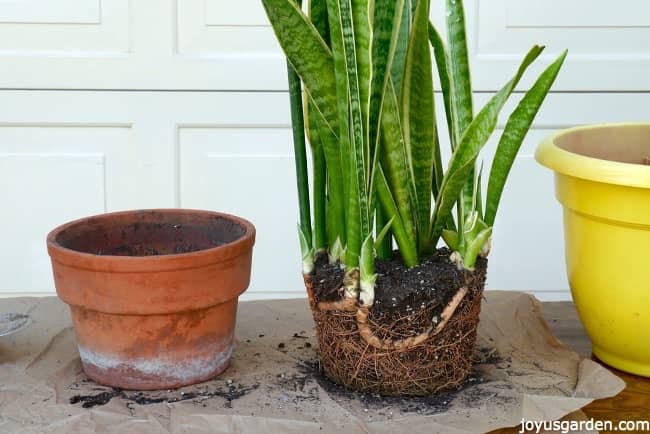
Repotting Snake Plants, Step By Step
Good to know: A Snake Plant’s roots are tough, so you don’t have to be too precious when handling the rootball.
Gather your soil mix materials. Sometimes, I mix them up ahead, and other times, I mix them in the pot as I go along.
Loosen the plant from its current pot. If the rootball is stubborn and not readily coming out, I either gently press on the grow pot or run a dull knife around the perimeter. Both ways are clearly shown in the video.
Once the entire plant is out of the pot, measure how much soil mix you’ll need to raise the top of the root ball to about 1/2″ above the rim of the new pot. The weight of the plant will eventually pull it down in the light mix. Then, add the new soil mix.
Place the plant in the pot and fill in around the sides with the mix.
Top with a thin layer of worm compost and/or compost.
This guide outlines Snake Plant Care and will help if you’re a beginning gardener.
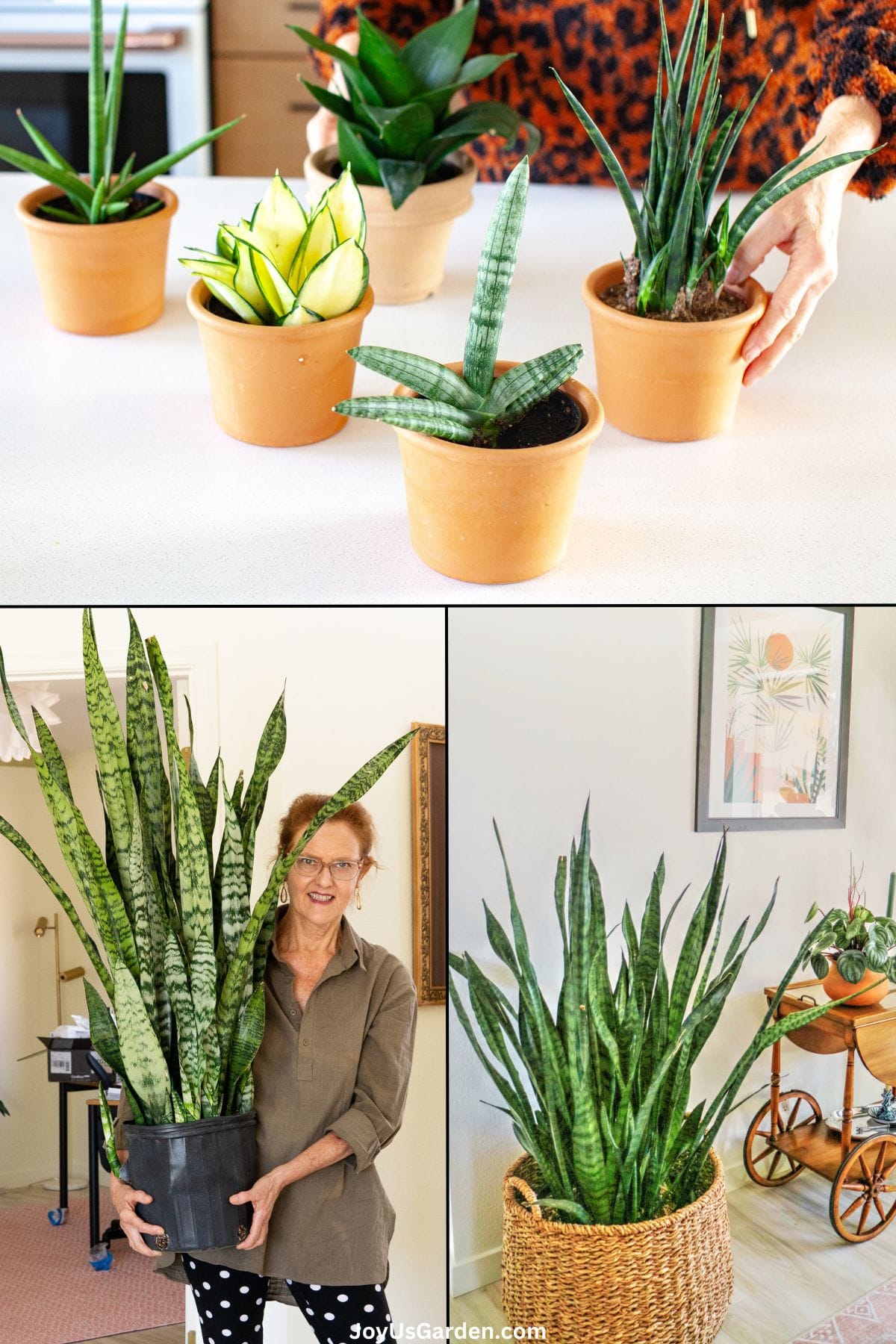
Can Snake Plants Be Divided?
Yes, I’ve successfully divided numerous Snake Plants. Their root balls are quite resilient. For larger plants, I use a sharp knife to split the root ball into the desired number of segments.
Snake Plant Care After Repotting
After the repotting process, I place the Snake Plants back in their original growing spot. They thrive in indirect sunlight, so keeping them away from hot, sunny windows that could scorch their leaves is important.
Snake Plants are succulents, which means they prefer dry conditions. To help them adjust after repotting, I refrain from watering for about 5 to 7 days. This dry period allows their roots to settle and prevents any potential rot.
Once they’ve had time to acclimate, I resume their regular watering schedule, ensuring they remain healthy.
Do Snake Plants need to be repotted? How Often Should You Repot Snake Plants?
Snake Plants don’t mind being tight in their pots. They actually do better if the root system is a bit pot-bound. I’ve seen quite a few root-bound plants actually break their grow pots, and they’re growing just fine. Of course, a bigger pot would be appreciated!
I have a few Snake Plants I haven’t repotted for over five years. Don’t rush to repot yours unless it looks stressed or has cracked the grow pot.

Repotting Snake Plants Video Guide
Repotting Snake Plant FAQs
Houseplants appreciate fresh soil at some point. Snake Plants like a chunky soil mix that drains freely and is well aerated. They store water in their rhizomes and thick leaves, so you don’t want the soil to stay consistently wet. I always use potting soil combined with succulent potting mix.
I wouldn’t recommend using straight potting soil because it could be too heavy and hold too much water. You want to use a well-draining soil mix. Add pumice, perlite, or pebbles to up the ante on drainage and aeration. See the “Soil” section for more details on these amendments.
If the grow pot is cracked, that’s one sign it needs repotting. Generally, I repot my Snake Plants every 4-6 years.
Snake Plants do fine growing tight in their pots. At some point, they’ll appreciate a bigger pot, which gives the rhizomes more room to spread.
No. Their rhizomes spread out rather than grow deep. A deep pot means more soil mass, which can cause the root ball to stay too wet.
Some, like the Bird’s Nest varieties, do just fine in smaller pots. As the taller species and varieties grow, they’ll need larger pots.
When repotting a snake plant, a general rule of thumb is to go up one pot size to avoid an excess of soil mass. I often use azalea pots because they have a lower profile and provide better drainage.
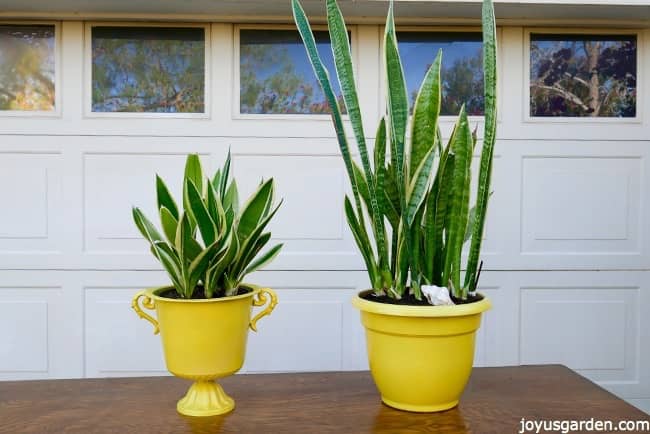
Conclusion: If you’re new to houseplant gardening, repotting Snake Plants might seem daunting, but with the right approach, it’s a straightforward process that can invigorate your plants and encourage healthy growth. Your Snake Plants will thrive in their new pots if you follow these steps and pay attention to their sunlight and watering needs.
Happy gardening!

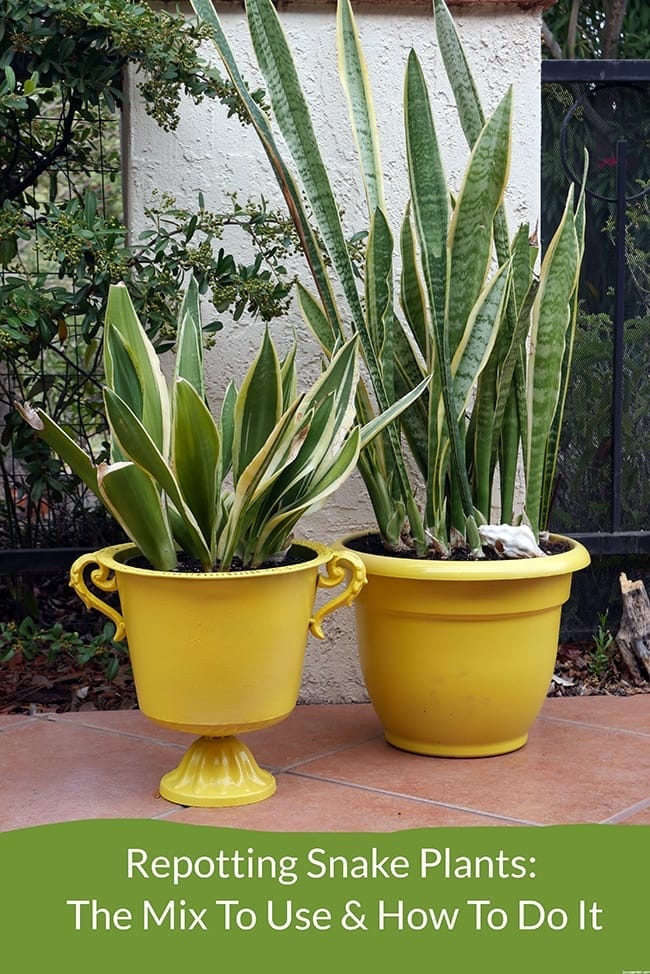

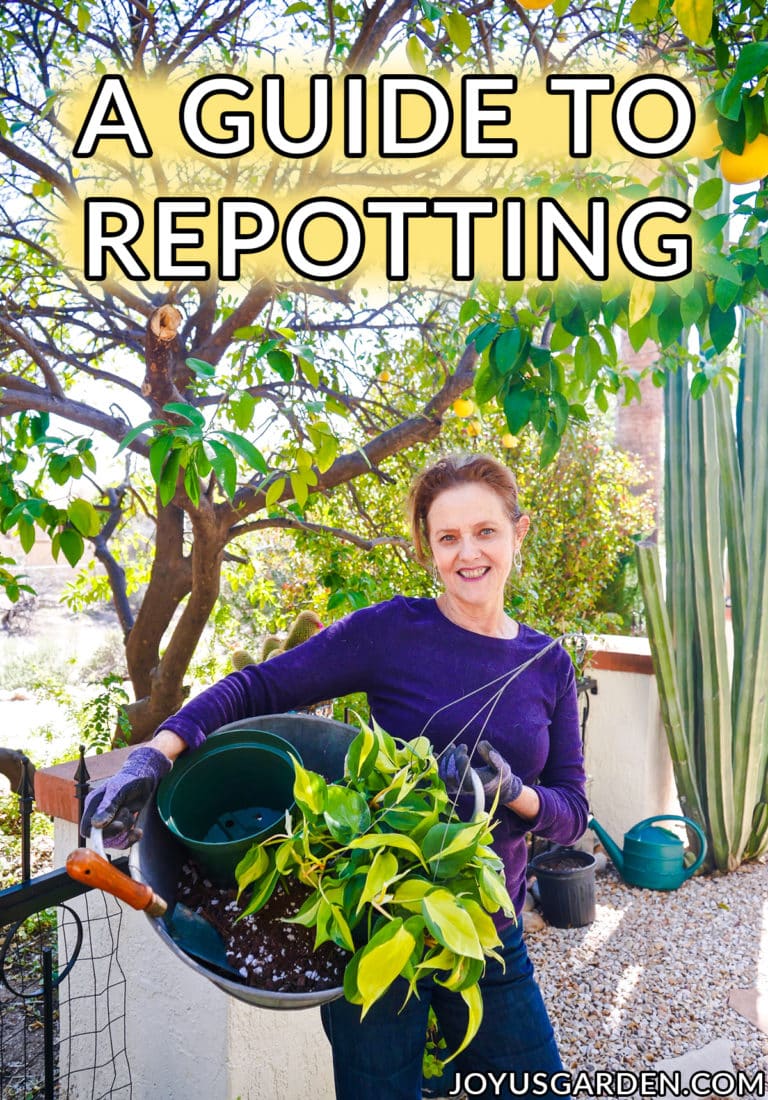
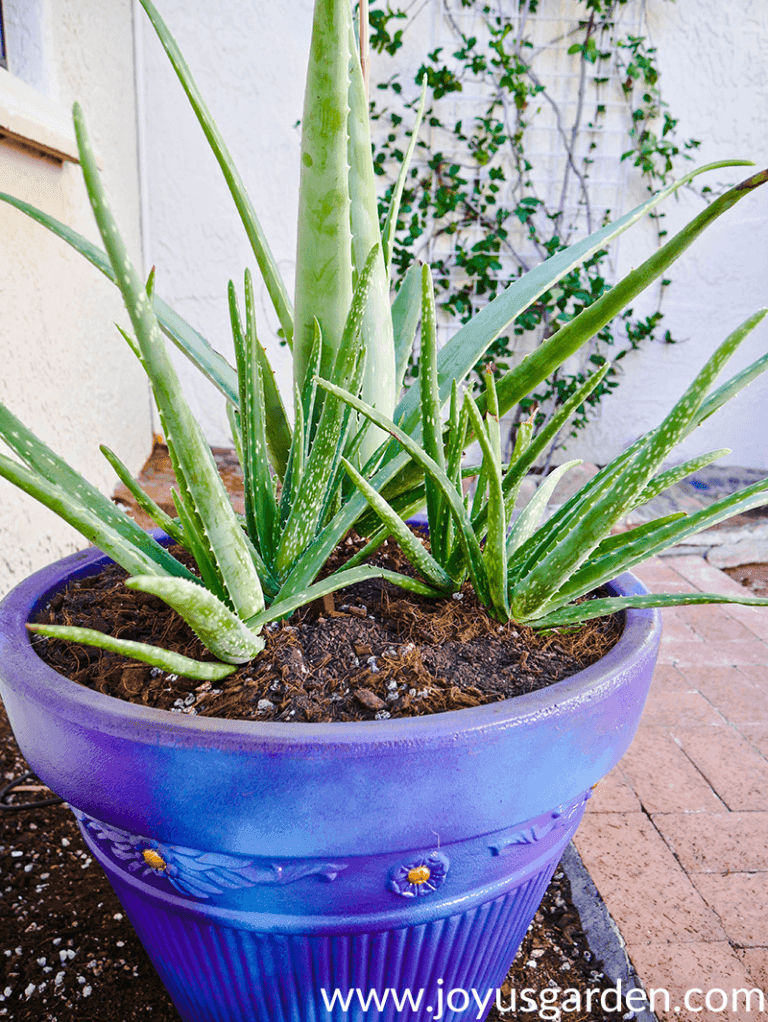

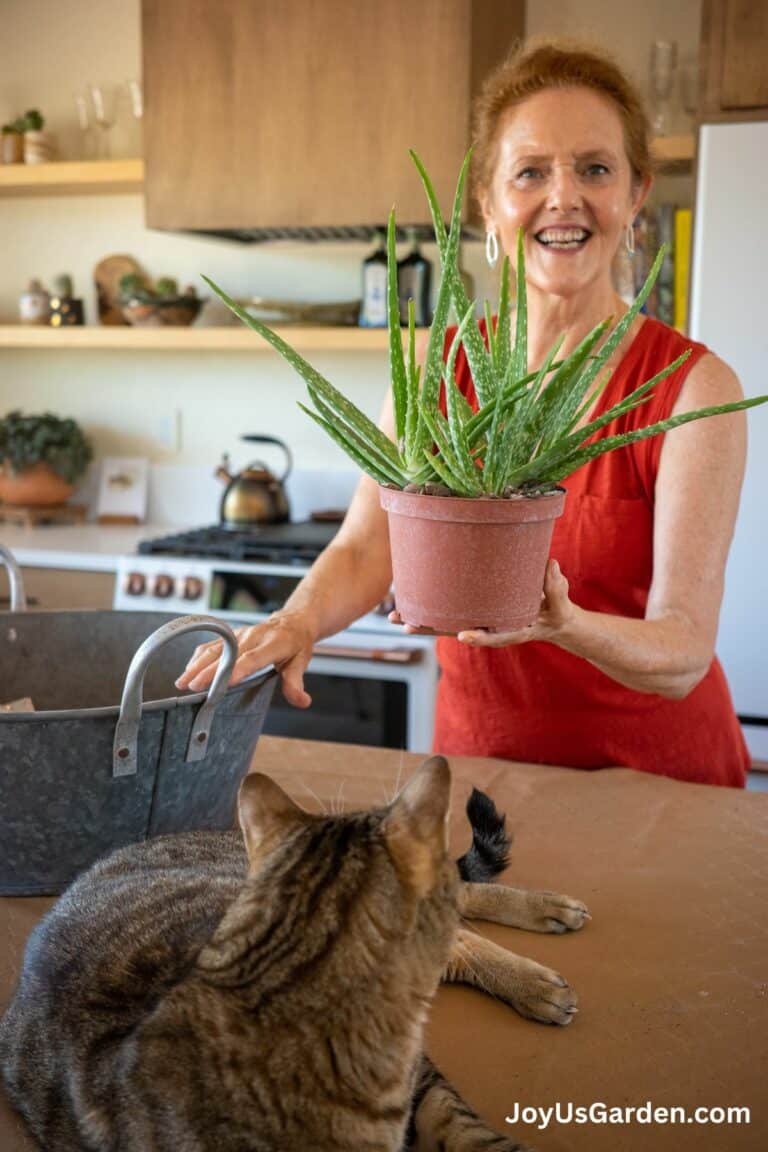

Those yellow pots really accent the plant!
Can you replant the leaves if they break off?
Hi Julie – Yes you can. A few of the leaves on mine bend completely over & cut them off. I let them heal over for at least a week & then plant them; either back in the same pot with the mother plant or in a separate pot. I’ll do a post & video on this within the next few months. Nell
I thank you for your help I love snake plants and want to be sure I am doing my best for them. However I have a problem. Two of my plants seem to be top heavy and are bending at the top of the soil. What can I do.
Hi Cheryl – I love snake plants too. There could be a few reasons that’s happening so I can’t exactly say what to do about it. The leaves of the taller varieties get heavier as they get tall & naturally bend. 2 of mine do that but not too often. I cut them, heal them & then plant back in. Other reasons: too wet or too little light. Nell
Hi Nell!
Great blog than you Nell!
A friend has a snake plant and told me a number of the leaves had fallen over. I asked her what she did with the fallen leaves and she told me she’d popped them in the compost ?? They’d only spent a couple of days in the compost so, I retrieved them, took them home and popped them (5 in total) in a jar keeping just enough water to cover the very bottoms of them. I checked them nearly everyday in the hope they’d grow roots which they did after 4 weeks. SO happy! I kept them in the jar for about 5 months. Why 5 months? because I had NO idea what to do with them and was hesitant to move them because I didn’t want to kill them! Anyhow, I took the plunge last week and potted them. After finding your blog this morning I’m pretty sure I’ve done the right thing by them. I’m hoping they survive their transplant.
Thanks again for the great info!
Cheers, Lynnie ? ?
Oh great Lynnie! Thanks for sharing. I usually let my fallen leaves heal over for a few weeks & then plant them back in the same pot. They’re really tough so I’m sure yours will be fine. Just don’t over water them! Nell
Just curious, do you need to add regular potting soil? Would straight c & s mix work?
No you don’t. Straight c & s mix would be just fine too Ty. The important thing is that the mix drains well so the roots & rhizomes don’t rot. Nell
Hi Nell,
What a wonderful site with informative information. I live in northern New England and have a beautiful mother-in-law’s tongue a friend gave me three years ago and glad I read your blog because I was just about to order all purpose soil for it. That would have been a mistake and now I will order the right soil and worm stuff. Thank you and I will continue reading your info. Wonderful!
Anita
PS- I have the large 5 ft tall plant in my large, very warm sun room with Southwest exposure.
Hi Anita – Thank you. I’m so glad you find our site to be helpful. You gotta love Snake Plants! I live in the Arizona desert & you live in northern New England & ours are thriving. You can grow them in potting soil but I’ve found from experience that they do better in the mix I refer to in the post. I use worm castings for most of my houseplants (except bromeliads, orchids, etc). Go easy on it indoors (a 1/2 to 1″ layer is enough depending on pot size). I plan on doing a post & video on this subject in 1-2 months. Happy gardening! Nell
Hi there!
Had a question… I planted two separate snake plants together in one large pot. I used the miracle grow cactus and succulent soil mixed with some miracle grow moisture control. I think I made a mistake and should have researched beforehand… I’m a newbie. Do my plants have any chance at survival now? Soil is pretty dry and haven’t watered since transplanting yesterday.
Thanks,
Liz
Hi Liz – I don’t use moisture control soil mix. Snake Plants, like most houseplants,like to dry out in between watering. I water mine every 3 weeks. Being on the dry side won’t hurt them, being too wet will. Nell
Hi Nell, I am new to the world of houseplants, and find your videos and website to be very helpful, thank you for all the good stuff! I just brought 2 small snakeplants (Golden Hahnii variety) from the nursery. I want to have them repotted to better pots, but not sure if I should keep them both in a single pot or plant each separately into 2 pots. What would you suggest ?
Ben
Hi Ben – Thank you – welcome to the wonderful world of houseplants! I’ve planted them together & separately so that’s your call. Snake Plants don’t mind being tight in their pots but if you decide to pot them together, of course you’ll need a larger pot. Just don’t get one too big though! Nell
I love my snake plant. A beautiful shoot grew taller than the main plant. But now the main plant is drooping over. Please help! Need to replant?
P S tried to attach a photo but couldn’t paste here.
Thank you!!
Hi Terri – It’s hard to say because I don’t know what’s causing it. If the main part of the plant is drooping, 1 cause could be over watering. Nell
I have 2 snake plants indoors that I’ve had for several years. Both get sufficient light and I hardly water them since I read they don’t need alot of water. I let them get very dry before watering and I don’t soak them at watering time. However, some of the leaves look shriveled and are starting to bend over. What am I doing wrong?
Hi Gloria – Shriveled leaves are a sign of not enough water. Mushy leaves are too much. To give you an idea: I live in the Arizona desert & water my SPs thoroughly every 3 weeks. A little less often in the winter. Nell
Hi Nell. I have a snake plant still in the plastic pot that I purchased it in several years ago. It sits in a clay pot on my covered patio. It gets watered with the hose when I happen to be outside; not on a regular basis. It’s basically ignored. I noticed that it has busted through the plastic pot. I would like to repot it and bring it inside, which is what I originally intended to do. Shld I replant it in another plastic pot, so that I can remove it from the decorative pot when I water it? Don’t want it to drain through onto the floor. Or, shld I transplant into a terra-cotta pot and leave it outside where it seems perfectly content to being ignored? I live inSan Diego. Thank you.
Either would work fine Maxine – Snake Plants aren’t fussy as to what type of pot they’re grown in. They do break though grow pots over time, as you know. I used to grow them outdoors in bright shade when I lived in Santa Barbara. I currently have mine growing in 3 different types of pots & all are doing great. Nell
How long does Snake plant take to grow?, also, what is the best way to water them (eg. spray them, or straight to the soil?)
Hi Carlo – It depends on the growing situation. Here in Tucson where it’s warm for many months, mine grow faster than they did when I lived in San Francisco which has fog & is much cooler. Although they aren’t high light plants, they grow faster with more light. Water them via the soil – they don’t need misting. Nell
Hi! I’ve enjoyed reading over your website and watching your videos. They’ve been very helpful. I recently purchased two snake plants from Lowes that were each in a 9″ plastic pot. My goal was to combine them together to make a larger plant to use indoors. The pot I purchased has a tapered shape and is 13.5″ D at the top of the new pot (does have drainage holes). Is this too large? I thought it would be ok but when I started to repot I ran out of soil; need a few more inches at the top. It’s hanging out like that until I can get more. I didn’t water yet. The plant needs adjusted some for centering but there will still be a few inches of space around the top of the new pot. I wish I could attach a photo. Ideally I would have liked to add more leaves but when I went back for another plant they were out. I would like the plant to continue to grow upwards. There are very tall leaves in the center of each plant but the surrounding leaves were various heights starting about half the height of the tallest leaves.
Thank you!
Hi Alisha – Thank you! If you’re potting up sansies in 2 – 9″ pots into a 13.5″ diameter pot, they’ll do fine. They don’t mind growing tight in their pots. I’ve combined Snake Plants in various pots & they’ve all done fine. Nell
Hi Nell.
Nice website. Thanks.
2 of my favourite plants are MILT and Aloe Vera which both grow pretty good in pots in my garden here in North Thailand. The pots are sitting on soil and have holes in the bottom so drainage is good and presumably the roots are extending into the soil beneath. I haven’t lifted them so I am guessing. One of my MILT plants has been in the same medium/large pot for at least 10 years cos it was in the garden when we bought the property.
I give both the MILT and the Aloe Vera moderate water and use a small amount of wood ash for mineral replacement I don’t add anything else. They appear to be thriving well.
I tried using wood ash in combination with nitrogen fertiliser that we use on our crops on some other plants I have. Disastrous! The soil turned into an Ammonium factory that I could have sold to Monsanto!
I also have Lucky Bamboo in vertical sided drinking glasses on the table on my verandah. No soil, no pebbles. They get early morning direct sunlight. The rest of the day they are in shade. But UV radiation remains high all day. I just give them a refill of oxygenated water every few days. Nothing else.
Seems to be working. No algae, and the roots are clearly growing.
I also have a cactus which is now 7 foot tall having grown it from a straggling root 4 years ago. He lives
in a medium sized pot with a hole in the bottom resting on soil.
Any advice on looking after Aloe Vera ( which looks like a cactus but isn’t ) and cactuses, appreciated.
I am pretty sure North Thailand is very similar to the Arizona desert. But when it rains here we are talking a serious drenching.
Have a nice day!
Chris.
I repotted 2 snake plants into one. Some of the leaves are very pale yellow at the bottom. Did I not plant them deep enough?
Hi Jimmie – As long as the rhizomes & roots are covered, the plant is fine. Could be too much water. Nell
State of leaf determines state of root. Same for any plant. The leaf is the barometer of the health of the plant. Leaf totally dependent upon the root that feeds it.
If I see a plant in my garden with leaves that don’t look right he is either getting too much or insufficient UV, too much or insufficient minerals, or possibly toxic chemicals. If he has rot at his base it is probably down to too much irrigation. Like Nell said. If the leaves of any plant, high or low, don’t look right. you need to take corrective action immediately. If not, your plant is under threat.
I watch my cactuses, snake plants and Aloe Vera very closely here in Thailand.
Ain’t growing plants just like a Kansas Combine Harvester reaps non-GM corn.
Best US beef is grass fed. Same with free-range chicken.
If the egg has an orange yolk it is highly likely to be OK. If the yolk is yellow the hen lived in a cage and was fed whatever made economic sense for the breeder.
A pretty plant in a pot is a pretty plant in a pot. Feel good factor. I have no problem with that. We need more plants on patios and inside houses.
But an agricultural plant is a totally different kettle of fish.
That applies to herbs and spices just as it applies to Pacific Salmon and Wagyu Beef.
Nature created.
Ain’t plants beautiful?
Home grown fruit and veg not only looks pretty, they are seriously healthy if you eat them.
An oxygen producing plant inside a US home is definitely good news.
Keep planting!
Chris
{ Brit living in agricultural Thailand and a Trump supporter. }
Hi. I recently potted two Sansevieria using MiracleGro’s Moisture Control potting soil assuming it would not retain too much moisture, but as I am reading up on Sanke Plant, I am wondering if I should re-pot them in a mix of cactus soil. A MiracleGrow rep claims they should be fine. Please advise. I know Sanke Plants do not like wet feet. Thank you.
Hi Jason – I’ve never used that mix before. I know it’s supposed to prevent both under or over watering but don’t know how it works with plants which like to be kept drier. You could always buy a small bag of succulent & cactus mix & try it 1/2 & 1/2. Nell
I have a snake plant that I want to make into 2 plants, what is the best way to do that? Also, if I’m just goi going to use potting soil and cactus soil what would be the ratio I would need to use? Thanks
Hi Kimberly – I either gently cut or pull them apart. Sometimes you can start by making a cut & them pull them apart, depending on how tight the rootball is. I use approximately 1/2 ps to 1/2 S & c mix. Nell
Hi Nell!
I am new to indoor plants. I recently bought golden pothos and spider plant for my living room . I used the readymade soil which was specially designed for indoor plants . I want to keep snake plant in my small bathroom , because it doesn’t need much water and can survive in dark with less sunlight. My question is should I just use the same soil which is specially made for indoor plants or should I have to do all the mixes you showed in the video.
I had used ” miracle grow indoor potting mix ”
Thanks
Zara
Hi Zara – Welcome to the world of houseplants! You can use potting soil but you might want to buy a small bag of perlite or pumice & add a bit of that in to facilitate drainage. With potting soil, you have to be very careful not to over water, especially with the Snake Plant in lower light. Nell
I only have 1 snake plant so what soil mixes would work for only 1 small house plant to be repotted. I don’t want to buy large bags that will dry out and have to throw away…your help is greatly appreciated…
Hi Shar – If only 1 small plant, I’d use succulent & cactus mix. You can find that in a small bag. Nell
I adore your content! I’m an AZ beginner plant momma myself and your content really helps me out!
Question for a large snake plant indoors… hope in the world do you find a nice pot that would be appropriate in size and drainage for indoors? I have one about the size maybe bigger than your bigger one you did.. help please!
Hi Chelsea! I’ve found some resin/plastic pots at HD & Lowe’s which are big & not expensive. This way, they’re easy to move around. And, I always paint them. Try Homegoods too. Nell
Hi Nell! Thanks for the video. 🙂
I bought my first Sansevieria Laurentii 6 years ago. I separated it yesterday and repotted each half into a new pot. One in their new homes, I watered them until the water drained into the saucer. Is this okay? I used a combo of pitting mix and succulent mix.
I noticed one of the leaves on one plant has a horizontal crack, almost through and through, on one of the long leaves— should I just cut it? Leave it? It droops.
Thank you 🙂
Hi Kris The mix sounds just fine. I let SPs settle in for 5-7 days before watering. If the leaf is drooping, cut it off. New ones will grow! Nell
I am starting to put my house plants outside. I have a snake plant that Wes in my mom’s room at assisted living. She passed away last year so in inherited her plants. It is doing really well. I am glad I found your site. It was very helpful for my needs as to finding out about watering and light. Thanks so much. Your videos are great too!
Oh thank you Karen! It’s wonderful your taking care of your mother’s plant – I’m sure they brought her joy. Nell
Hi there! Thanks so much for the helpful info. I just bought a snake plant for indoors and the pot I’d like to put it in is shallow. Here’s a picture of it: –> https://www.homedepot.com/p/Scalloped-Flare-15-in-Warm-Copper-Plastic-Low-Urn-DU903D/300005921 Does a snake plant have a deep root bed /system or will it be ok in a shallow pot? Thanks in advance! 🙂
Hi Melania – Snake Plants don’t root deep so in many cases, a more shallow pot is fine. However, the bigger & taller they get, the heavier they get. Then, they’ll need bigger pots as an anchor. Nell
I love the yellow pots . I just repotted a snake plant my grandmother gave me almost 30 years ago. It has been in the same pot ! They are tough but it has started to look not so healthy so we put it in potting mix in a larger clay pot. The mix was brand new but was very damp when we opened the bag. Now I am concerned that we may hasten the demise of this longtime family member. There is a lot of sentimental value since my grandmother passed away 16 years ago.
Roger – Thumbs up on yellow pots! Wow, I love it when plants have sentimental meaning. Hopefully,the mix will start drying out because Snake Plants can get overwatered easily. That’s why I use 1/2 cactus & soil mix when repotting them. I live in the desert & water my 2 large ones (4-5′ tall) every 2 months or so.
Oh, no. I wish I had seen this sooner. I divided and re-potted my snake plants in mostly coco coir, some compost, worm castings, and perlite about a month ago and the soil is still moist. Plant look fine though. Do you think it’s safe to re -pot again?
Kimberly – Snake Plants are tough so you could repot them. Nell
Hi Nell!
I have a beautiful tall snake plant for the past 2 years and absolutely love him! I water him sparingly and he has been growing tall, straight and strong.
However, I started to notice moss is growing in the base of his pot (brownish) — is this bad?
Looking forward to hearing back!
Dayna
Hi Dayna – I love Snake Plants too! Moss needs water to grow. It’s not going to hurt the plant but it does mean moisture is building up at the bottom. Nell
I recently bought a snake plant and would like to repot it. However I have a clear glass container I’m thinking of using, would my plant be negatively effected in any way?
Hi Tracy – I’ve never grown a Snake Plant in a glass container. I’ve seen it done but you’d have to use drainage materials (pebbles & charcoal) & be very careful not to overwater. Nell
I inherited 2 snake plants that are both 4 feet tall. Do you have a recommendation for the size of pot I need? Thank you.
Hi Anthony – My 4′ Sansevieria laurentii is in a 10″ grow pot & doing just fine. They like to grow a bit tight in their pots. Nell
I live in San Ramon Costa Rica. Not supplies here. Example If have Aquarium 1 or 2 store. If I can find succulents & cacti can I use cacti soil mix for Snake Plant, potting soil in most store. And Cacti sold at one store. But we have to go to bigger provinces in 2 hours or more we are in rainy season with heavy rains and maybe thunderstorms, leaving the house before 6:00 am.